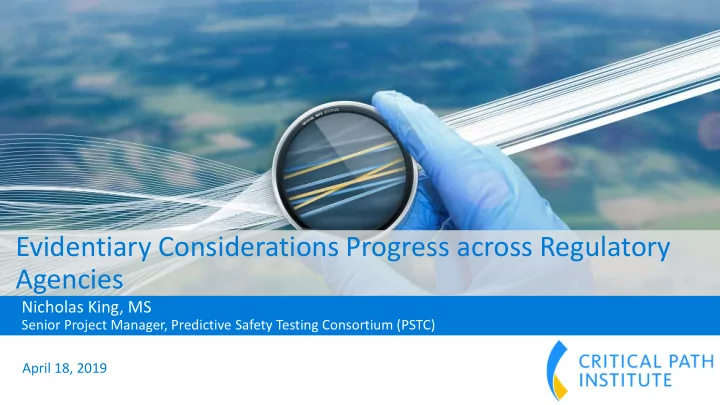

Evidentiary Considerations Progress across Regulatory Agencies Nicholas King, MS Senior Project Manager, Predictive Safety Testing Consortium (PSTC) April 18, 2019
Goal for Biomarker Qualification Evidentiary Criteria / Considerations The goal for defining evidentiary criteria is to: • improve the quality of submissions to the agencies, • enhance the predictability of the qualification process, and • clarify the type and extent of evidence needed to support the biomarker’s COU. 2
What is a Biomarker? • Biomarker: “A defined characteristic that is measured as an indicator of normal biological processes, pathogenic processes, or responses to an exposure or intervention, including therapeutic interventions. Molecular, histologic, radiographic, or physiologic characteristics are types of biomarkers.” • The biomarker is not the measurement technique or assay 3
Biomarker Qualification Objectives of Qualification • To qualify and make DDTs publicly available to be used for a specific context of use in drug development • To streamline drug development and review of regulatory applications • To facilitate integration of qualified DDTs in regulatory review • To provide a framework for scientific collaboration to facilitate DDT development 4
Qualifications Globally • EMA - Submit via the Novel Methodologies and request either Qualification Advice or Qualification Opinion • FDA - Multi-step program to obtain consensus on the appropriate path to a qualified Drug Development Tool • PMDA - Multi-step program to obtain consensus on the appropriate path to a qualified biomarker 5
BEST Biomarker Category and Examples of Corresponding Drug Development Uses 6
How to Determine the Level of Evidence Expected for a COU? 7
Evidentiary Criteria and Considerations Characterizing the relationship of biomarker to the • Clinical outcome • Biological rationale • Supporting patient level datasets (retrospective or proposed prospective) • Comparison to current standard • Assay performance • Statistical methods used 8
Evidentiary Considerations for Biomarker Qualification Biomarker Qualification vs. Marketing Acceptance of Drugs • The regulatory acceptance of a drug marketing application is based on a preponderance of data around the effectiveness and safety associated with the drug. • The regulatory qualification of a biomarker is based on the correlation of the biomarker with gold standard (hard) endpoints. 9
Evidentiary Considerations for Biomarker Qualification 10
Evidentiary Considerations for Biomarker Qualification Framework for Biomarker Qualification • Define a drug development need for the biomarker • Define a Context of Use (COU) for the biomarker • Assess the benefit associated with use of the biomarker in drug development in light of the COU • Assess the risk associated with use of the biomarker in drug development in light of the stated COU • Use this information to populate an evidentiary criteria map 11
Conceptual Framework for Biomarker Development For Regulatory Acceptance https://fnih.org/what-we-do/biomarkers-consortium/programs/framework-for-safety-biomarkers 12
EMA Process • Submit Letter of Intent and Briefing Package to align on project and receive Qualification Advice • Conduct Formal SAWP meeting with EMA • Qualification Advice released to submitter • Incorporate Qualification Advice into qualification project and execute project • Submit final Briefing Package to request Qualification Opinion 13
PMDA Process • Submit Letter of Intent • Submit Briefing Package to align on project plan • Conduct Formal Consultation Meeting to address Agency questions • Execute project based on project alignment / necessary criteria with PMDA • Submit Qualification Briefing Package • Conduct Formal Consultation Meeting to address final questions on Qualification • Qualification Briefing Package review and final statement 14
Regulatory Acceptance of Biomarkers Biomarker integration into drug development: 3 Pathways IND Individual drug development pathway (e.g. Investigational New Drug pathway) : based upon agreement with the division, in the context of a specific drug development program Scientifically-supported community implementation Scientific community consensus : broadly/widely used biomarker, appropriate scientific support, generally accepted by experts in the field FDA’s Biomarker Qualification Program Biomarker qualification program : review and acceptance based upon appropriate submission qualification package; available for use in any development program within approved context of use 15
Biomarker Qualification Qualification is a formal regulatory review and acceptance process of biomarkers for their use in drug development “Qualification is a conclusion that within the stated context of use, the biomarker can be relied upon to have a specific interpretation and application in drug development and regulatory review.” 16
Biomarker Qualification Drug Development Drug Development Need Solution 21 st Century Cures Act Section 507 Qualification of Drug Development Tools Letter of Intent Qualification Plan Final Qualification Package 17
Biomarker Qualification • Qualification results in scientific acceptance and Biomarker discovery regulatory certainty of the biomarker • Once qualified the information pertaining to the acceptable use of the biomarker in drug Biomarker testing development will be publicly available • Biomarker qualification not just biomarker discovery or clinical validation, it the formal acceptance of the Biomarker validation biomarker by health authorities for use in drug (analytical, clinical) development • Qualification does not denote that a biomarker is Biomarker qualification acceptable for use in clinical practice as an in vitro diagnostic or otherwise 18
Biomarker Qualification Roadmap to Biomarker Qualification 1. Need Statement: what is the knowledge gap or drug development need that the biomarker(s) are addressing. 2. Context of Use (COU) Statement : A concise description of the biomarker’s specified use in drug development. 3. Assessment of Benefit to the Patient: e.g., improved sensitivity or selectivity, better mechanistic context to graft loss, enable earlier intervention or selection of certain patients that otherwise wouldn’t be identifiable. 4. Assessment of Risk to the Patient : Consequences of a false negative or positive. 5. Evidentiary Criteria: characterizing the relationship of biomarker to the clinical outcome, biological rational, supporting patient level datasets (retrospective or proposed prospective), comparison to current standard, assay performance and statistical methods used . 19
Thank you 20
Recommend
More recommend